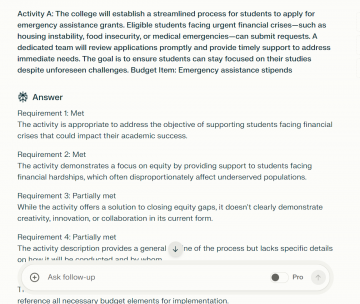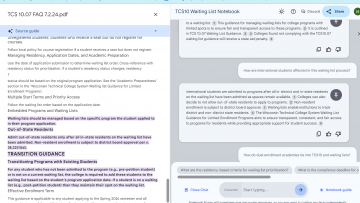AI as an Administrative Assistant
AI tools can help lessen the lift of administrative tasks and improve outputs. You can think of AI as an administrative assistant who can provide critical feedback, suggest alternative ways of phrasing content, check for alignment with requirements and provide immediate responses to questions. Below, we provide examples and prompts for using AI to improve grant applications and evaluate college policies. An important consideration in leveraging AI is identifying the best AI tool for the different tasks you need to perform. For instance, in the use case of improving college grants we tested a few AI tools and discovered that simpler chat bots (e.g., ChatGPT, Microsoft Copilot) did not accurately assess whether draft grant elements contained the required rubric items. Instead, a more robust AI tool, Perplexity.ai was needed to provide informative feedback for grant writing improvement.
Improving a Grant Application
For grant development, college grant writers can  use AI tools, such as Perplexity.ai, to evaluate whether drafted grant content aligns well with grant guidelines, rubrics and other reference material. Below, is an example prompt for evaluating the alignment of draft grant activities with rubric requirements. You will notice some of the core elements of an AI prompt. First, we assign a role to the AI tool. In this case, they are a successful grant writer. Then we provide necessary context with a sentence summarizing the intent of the grant category. Next, we provide a numbered list of the grant rubric elements that apply to the aspect of the grant we are evaluating: grant activities. Lastly, we specify the structure we want for the output and the specific elements we want included. This prompt can be adapted for different aspects of a grant application (e.g., statement of need, measurable objectives) and different grant categories. See this prompt in action with Perplexity.ai.
use AI tools, such as Perplexity.ai, to evaluate whether drafted grant content aligns well with grant guidelines, rubrics and other reference material. Below, is an example prompt for evaluating the alignment of draft grant activities with rubric requirements. You will notice some of the core elements of an AI prompt. First, we assign a role to the AI tool. In this case, they are a successful grant writer. Then we provide necessary context with a sentence summarizing the intent of the grant category. Next, we provide a numbered list of the grant rubric elements that apply to the aspect of the grant we are evaluating: grant activities. Lastly, we specify the structure we want for the output and the specific elements we want included. This prompt can be adapted for different aspects of a grant application (e.g., statement of need, measurable objectives) and different grant categories. See this prompt in action with Perplexity.ai.
As always, maintain ‘humans in the loop.’ The AI tools provides helpful feedback and suggestions, yet ultimately an experienced grant writer needs to assess whether or not all suggested improvements are necessary and how to implement any aspect of the feedback.
Try an example prompt:
You are a successful grant writer at a college. We are applying for a grant to create, expand and/or implement innovative strategies through direct services for students experiencing gaps in student success outcomes who are enrolled in post-secondary courses, career pathways or adult education/English learning opportunities. The activities for the grant must include: (1) Activities are appropriate to address respective objectives, (2) Activities demonstrate a focus on equity in student success, (3) Activities demonstrate creative, innovative, and collaborative solutions to closing equity gaps, (4) Describes activities clearly and includes how each will be conducted and by whom and (5) Each activity description references all budget elements necessary for implementation. I will provide you with a draft of an activity and I would like you to assess whether it meets these requirements, what the strengths and weaknesses are, and provide ideas for how to improve the content to make it more competitive for funding (e.g., make the content easier to understand, more succinct). I want the output to follow this format:
Requirement 1: Met or not met with explanation
Requirement 2: Met or not met with explanation
Requirement 3: Met or not met with explanation
Requirement 4: Met or not met with explanation
Requirement 5: Met or not met with explanation
Strengths in a bulleted list.
Weaknesses in a bulleted list.
Ideas for specific improvements in a bulleted list.
If you understand please respond ‘Let’s get funded’.
Additional ideas for leveraging AI in grant development:
- Provide multiple examples of recent successful and unsuccessful grant applications within an AI model to extract the key elements that help make grants competitive for funding. If available, include grant reviewer comments to inform the AI output.
- Need to shorten the content to fit word count requirements? Provide the draft grant content in an AI prompt to trim unnecessary words without losing the meaning or impact of the text.
Aligning College Policies and Procedures with External Requirements

Google NotebookLM for TCS10 Program Waitinglist Guidance referencing content in the WTCS TCS10 FAQ document.
In the context of aligning college policies and procedures with external requirements, the integration of AI chatbots (e.g., Google’s NotebookLM) can be a transformative approach. These chatbots can serve as an immediate reference tool, providing quick access to a wide array of reference content including PDFs, websites, and other reference materials related to HLC accreditation, federal reporting requirements, statutory language, the WTCS Educational Services Manual, and more. By incorporating AI chatbots into the policy development process, college teams can efficiently navigate through complex information, retrieving relevant citations and clarifications on-demand. This reduces the time spent searching through extensive documentation and waiting for email responses from online helpdesks.
Once policy drafts are prepared, tools like Perplexity.ai can be used to evaluate the draft, ensuring the policies follow the necessary external requirements. The prompt below provides an example for how to use AI to assess academic program admission policies for compliance with TCS10. See this example in action. These tools can also analyze the language used in the policies to identify and mitigate any potential biases, ensuring that the policies are equitable and inclusive. This innovative use of technology not only streamlines the policy development process but also enhances the quality and reliability of the policies created.
Try an example prompt:
You are a college auditor who is adept at evaluating policy language against external requirements. We are evaluating the college’s Program Enrollment Policy to ensure that it complies with Wisconsin Administrative Code TCS10.07. Attached is the guidance for TCS10.07 for your reference. I will then provide draft text from our policy and I would like you to check for alignment and identify any areas that are out of compliance and suggest specific ideas for improvements. I want the output to follow this format:
Bullet point list of the aspects of the draft policy that fully align with the TCS10.07 guidance.
Bullet point list of the aspects of the draft policy that do not align with the guidance and need improvement. For each identified area that does not align suggest specific ideas to fix the misalignment.
If you understand please respond ‘Let’s audit’.
